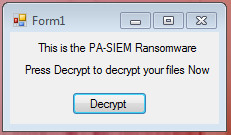RANSOM_PASIEM.A
Windows


Threat Type: Ransomware
Destructiveness: No
Encrypted: No
In the wild: Yes
OVERVIEW
Dropped by other malware, Downloaded from the Internet
This Ransomware arrives on a system as a file dropped by other malware or as a file downloaded unknowingly by users when visiting malicious sites.
It encrypts files found in specific folders.
TECHNICAL DETAILS
11,776 bytes
EXE
No
24 Aug 2017
Encrypts files
Arrival Details
This Ransomware arrives on a system as a file dropped by other malware or as a file downloaded unknowingly by users when visiting malicious sites.
Ransomware Routine
This Ransomware encrypts files found in the following folders:
- C:\Users\breach
It appends the following extension to the file name of the encrypted files:
- .PA-SIEM
NOTES:
Sends Key to http://{BLOCKED}.{BLOCKED}.0.3/Ransomware/index.php?key= {key 1} &iv= {key 2}
Shows the following window after execution:

Decrypt button decrypts encrypted files.
SOLUTION
9.850
13.616.08
25 Aug 2017
13.617.00
26 Aug 2017
Step 1
Identify and terminate files detected as RANSOM_PASIEM.A
- Windows Task Manager may not display all running processes. In this case, please use a third-party process viewer, preferably Process Explorer, to terminate the malware/grayware/spyware file. You may download the said tool here.
- If the detected file is displayed in either Windows Task Manager or Process Explorer but you cannot delete it, restart your computer in safe mode. To do this, refer to this link for the complete steps.
- If the detected file is not displayed in either Windows Task Manager or Process Explorer, continue doing the next steps.
Step 2
Scan your computer with your Trend Micro product to delete files detected as RANSOM_PASIEM.A. If the detected files have already been cleaned, deleted, or quarantined by your Trend Micro product, no further step is required. You may opt to simply delete the quarantined files. Please check this Knowledge Base page for more information.
Step 3
Restore encrypted files from backup.
Did this description help? Tell us how we did.

